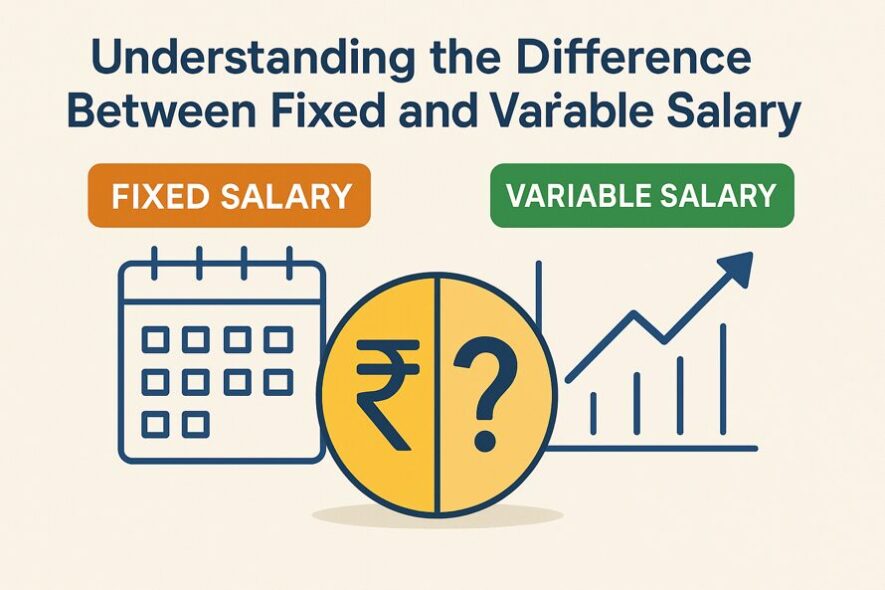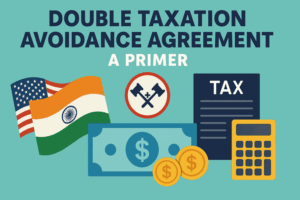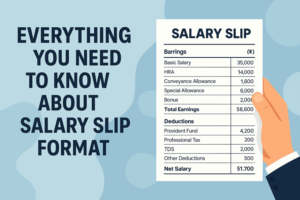
Understanding Salary Structure
When you look at a job offer, the salary figure always grabs attention. But that single number or CTC has two parts, fixed and variable. Fixed pay is the steady component; variable pay depends on both the employee’s performance and the company’s performance. Together, they determine how much you actually take home in a year.
What is a Fixed Salary?
Fixed salary is your anchor. It hits your account on the same date every month, whether or not you had a great quarter. It covers your basic pay and allowances. Think of it as the money you budget for rent, groceries, bills, and school fees. If your fixed pay is ₹45,000 a month, you can rely on that number like clockwork.
What is a Variable Salary?
Variable salary is the extra layer on top. It rises or falls based on how you perform or how the company performs. Bonuses, incentives, and commissions all fall under this bucket. Some months or years, it could double your take-home. For example, a sales executive might have a fixed salary of ₹30,000 but can earn an additional ₹40,000 in incentives if targets are met.
Why Employers Use Both Components
Companies design pay this way for a reason. Fixed pay provides stability, which employees need. Variable pay pushes people to go beyond the minimum and chase results. A bank clerk may get 90% fixed and 10% variable, while a stockbroker may get 50-50. In roles where output directly drives revenue, like sales or trading, companies load the salary with more variable pay to push performance harder.
Key Differences Between Fixed and Variable Salary
Fixed and variable salaries may sit in the same payslip, but they behave very differently. One feels safe and predictable, the other feels like a reward. Knowing how they work side by side helps you manage money and make career choices.
Payment Frequency and Consistency
Fixed salary is paid on a set date, every month, without fail. You can plan your bills and EMIs around it. Say your fixed is ₹60,000; you know it will be credited on the last working day of the month.
Variable pay has no set rhythm. Some companies release it once a quarter, others wait until year-end. A sales manager might walk away with a ₹1 lakh incentive in March but nothing in June. It’s lumpy, and that makes it unreliable for everyday expenses. Think of it as seasonal rain rather than steady tap water.
Performance Dependency
Fixed pay ignores performance. You show up, do your job, and you get it. It’s the foundation of your package.
Variable pay is the opposite. It directly depends on performance. If you achieve sales targets, bonuses kick in. If your team completes a project early, you may get a reward. Senior leaders often have pay linked to company profits or share price. Take a marketing manager with ₹40,000 fixed. If their campaign meets targets, they may pocket another ₹20,000 as variable. That link to output adds excitement but also uncertainty.
Taxation and Deductions
Fixed salary usually comes with standard deductions. Provident Fund, professional tax, and insurance contributions are deducted from it. These reduce what you get in hand but also add long-term benefits.
Variable pay is fully taxable in the year you receive it. Suppose your fixed salary is ₹6 lakh annually. You bag a ₹1 lakh performance bonus. Your taxable income becomes ₹7 lakh for that year, and that can push you into a higher tax bracket. Timing matters here; bonuses feel great, but also bump up tax liability.
Impact on Take-Home Pay
Fixed pay is the backbone of your monthly take-home. It covers recurring needs and keeps your financial life steady. Without it, financial planning would go for a toss.
Variable pay, though, can turbocharge your finances when it arrives. A fat year-end bonus can clear a chunk of your home loan, or it can go into stocks, mutual funds, or gold. But it’s not wise to rely on it for routine groceries or rent. That’s why many financial planners suggest treating variable income as a bonus, park it into savings, retirement funds, or big goals like a child’s education.
Components of Fixed and Variable Salary
Salary packages contain many elements. Some are fixed, while others change based on performance. Let’s break down each part.
Examples of Fixed Pay Elements (Basic, HRA, DA)
- Basic Salary
This is the spine of your paycheck. It usually makes up 35–50% of your package. If your monthly salary is ₹60,000, your basic could sit around ₹25,000. It’s fully taxable, but it’s also the number used to calculate benefits like Provident Fund and Gratuity. Since it lands in your account every month without fail, it’s the most dependable part of your earnings.
- House Rent Allowance (HRA)
HRA is designed to ease rental expenses. Say your package includes ₹15,000 as HRA. If you pay rent, you can claim a tax exemption on part of it, depending on your rent amount, your basic salary, and whether you live in a metro or non-metro city. If you rent in Mumbai or Delhi, your exemption will usually be higher than in a smaller town. But if you own your house or don’t pay rent, the allowance becomes fully taxable.
- Dearness Allowance (DA)
DA is common in government and public sector jobs. It’s meant to fight inflation. The allowance is calculated as a percentage of your basic salary and revised twice a year, usually in January and July, based on the Consumer Price Index. For example, if your basic is ₹30,000 and DA is fixed at 42%, you’ll earn another ₹12,600 as DA. This ensures your salary grows in line with rising prices, so your purchasing power doesn’t shrink over time.
- Other Fixed Components:
- Medical Allowance: A set amount to cover medical expenses, often ₹1,250–₹1,500 per month.
- Transport Allowance: Helps cover commuting expenses. For example, ₹1,600 per month was the standard exemption limit earlier.
- Leave Travel Allowance (LTA): Covers travel costs when you take leave and travel with family. The exemption applies to actual travel expenses, subject to conditions, and is available twice in a block of four years.
All these fixed elements are predictable and included in every month’s salary, making them easy to plan around.
Examples of Variable Pay Elements (Bonuses, Incentives, Commissions)
- Performance Bonus
Think of this as a pat on the back in cash. You hit your yearly targets, and the company rewards you. For instance, if the goal is to bring in 500 new customers and you achieve it, you might receive a bonus of ₹50,000 at year-end. It’s usually a one-time lump sum that makes the grind worth it.
- Sales Incentives
This one fuels sales roles. Say you earn a fixed ₹25,000 per month. Your company sets a target of 50 units. Anything above that earns you ₹1,000 per unit. You sell 70 units in a month. That’s 20 extra × ₹1,000 = ₹20,000 on top of your fixed. Your take-home jumps to ₹45,000.
- Commissions
A straight percentage of the revenue you generate. It’s common in real estate, insurance, and financial products. Close a ₹50 lakh property deal at a 2% commission, and you take home ₹1 lakh. The bigger the deal, the bigger the commission. That’s why agents chase high-value clients with so much energy.
- Other Variable Elements:
- Profit-Sharing: At year-end, companies may set aside part of their profits and distribute them across employees. It gives everyone a sense of ownership.
- Retention Bonus: Companies pay this when they want you to stay through a critical project or period. It locks in talent and reduces attrition.
- Project Completion Reward: Finish a project early or under budget, and you may get a cash reward. It’s the company’s way of saying, “Great job, you saved us time and money.”
Variable pay feels exciting because it spikes income, but it’s also unpredictable. Some years you’ll see fat bonuses, and some years you may get nothing. That’s why most people treat it as extra money, which is great for investments, vacations, or clearing loans.
Advantages and Disadvantages
Every pay structure has its strengths and weaknesses. Employees and employers must balance them wisely.
Pros and Cons of Fixed Salary
Pros:
- Predictable monthly income
- Easy financial planning
- Stability in times of uncertainty
Cons:
- Limited motivation for higher performance
- Inflexible for employers during downturns
Pros and Cons of Variable Salary
Pros:
- Motivates employees to achieve targets
- Rewards high performers with higher earnings
- Helps companies control fixed costs
Cons:
- Unpredictable income for employees
- Stressful in target-driven roles
- May lead to unequal earnings within teams
Balancing Both for Financial Stability
An ideal salary structure combines both. Fixed pay covers basic needs, while variable pay adds motivation. For example, an IT professional may get 80% fixed and 20% variable, while a sales executive may get 60% fixed and 40% variable.
How Fixed and Variable Pay Influence Career Choices
The ratio of fixed vs variable salary often guides career decisions. Some roles give steady income, while others promise high rewards with performance.
Roles with Higher Fixed Pay
Government jobs, banking roles, IT development positions, and administrative jobs typically offer high fixed pay. These are suitable for people who prefer stability.
Jobs with High Variable Earnings Potential
Sales, investment banking, real estate, and business development roles carry high variable pay. In these jobs, high performers can earn much more than their fixed salary.
Industries Where Each is Common
- Fixed-heavy industries: Education, healthcare, government, IT services
- Variable-heavy industries: Sales, financial services, consulting, startups
How to Evaluate Job Offers Based on Salary Structure
When comparing offers, don’t just look at the total CTC. Break down the fixed vs variable salary to understand how much you’ll actually receive each month.
Interpreting CTC vs In-Hand Salary
CTC (Cost to Company) includes fixed, variable, and perks. In-hand salary is what you receive monthly. A job with high CTC but low fixed pay may feel less rewarding day-to-day.
Assessing Risk vs Reward in Variable Pay
High variable pay offers upside but comes with uncertainty. Ask yourself: Can you handle months where bonuses are delayed or lower? For example, if your role offers 50% variable pay, ensure you have savings to cover low-earning months.
Questions to Ask HR During Offer Negotiation
- What percentage of salary is variable?
- How often is variable pay released?
- What performance metrics decide my variable pay?
- What’s the historical payout rate for employees in this role?
Conclusion
Understanding fixed vs. variable salary is key to making smarter career decisions. Fixed pay offers security, while variable pay offers growth opportunities. Employers use this mix to balance costs and motivate employees.
A balanced salary structure not only supports day-to-day living but also drives long-term career satisfaction.
FAQs:
Q. What is the major difference between fixed and variable salary?
Fixed is stable monthly pay, variable depends on employee and company performance.
Q. Is variable pay guaranteed?
No, it’s linked to targets or company results.
Q. How much of my salary should be fixed vs variable?
Ideally, at least 70% fixed and the rest variable.
Q. Which is better, fixed salary or variable salary?
Fixed gives stability, variable adds upside.
Q. How does variable pay affect my income tax?
It’s fully taxable in the year you receive it.
Q. Are incentives the same as variable pay?
Yes, incentives are a type of variable pay.
Q. Can a variable salary be more than a fixed salary?
Yes, in sales or target-driven roles, it often is.







